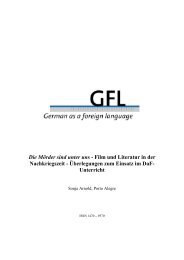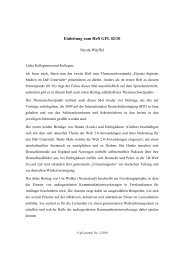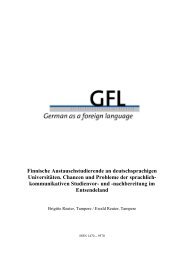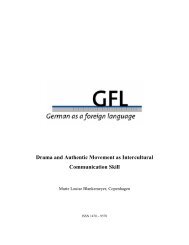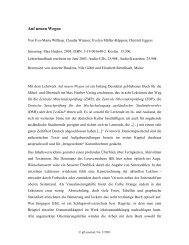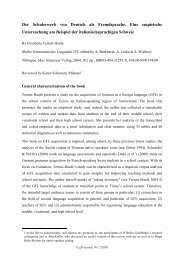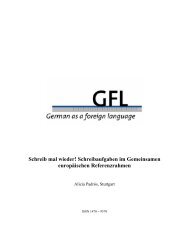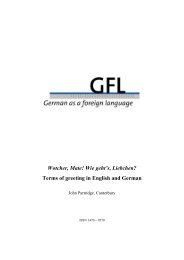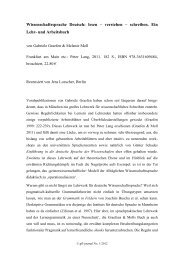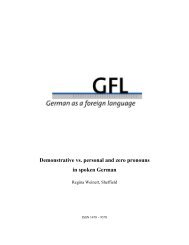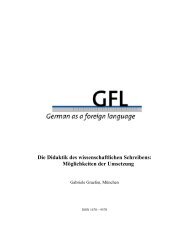KLARO! A practical Guide to German Grammar ... - GFL-Journal
KLARO! A practical Guide to German Grammar ... - GFL-Journal
KLARO! A practical Guide to German Grammar ... - GFL-Journal
Create successful ePaper yourself
Turn your PDF publications into a flip-book with our unique Google optimized e-Paper software.
<strong>KLARO</strong>! A <strong>practical</strong> <strong>Guide</strong> <strong>to</strong> <strong>German</strong> <strong>Grammar</strong><br />
Susan Tebbutt<br />
London/NewYork: Arnold, 2001, 200 pp., ISBN: 0 340 76020, (Pb.) £12.99<br />
<strong>German</strong> <strong>Grammar</strong> in Context; Analysis and Practice<br />
Carol Fehringer<br />
London/NewYork: Arnold, 2002, 226 pp., ISBN 0 340 763108, (Pb.) £14.99<br />
Essential <strong>German</strong> <strong>Grammar</strong><br />
Durrell, Martin; Kohl, Katrin; Loftus, Gudrun<br />
London/NewYork: Arnold, 2002, 305 pp., ISBN 0 340 741889, (Pb.) £14.99<br />
Reviewed by Astrid Kuehlmann-Lee, London<br />
Language teachers will be delighted <strong>to</strong> find such a wide choice of new <strong>German</strong> grammar<br />
books for English-language learners. Coming from the same publishing house (Arnold),<br />
they aim at different segments of the market. <strong>KLARO</strong>! is a less weighty volume (intellectually<br />
and in Grams or Ounces) than the others and aims at the post-GCSE ‘improver’<br />
and lower-level university student. However, this does not detract from its real usefulness<br />
in this context and may well encourage students <strong>to</strong> carry it with them <strong>to</strong> dip in<strong>to</strong> during<br />
otherwise underused ‘waiting times’ not spent communicating by mobile phone.<br />
All the new grammar books are very user friendly and make appropriate concessions <strong>to</strong><br />
<strong>to</strong>day’s world dominated by visual images. All of them are more pleasing <strong>to</strong> the eye and<br />
present graphically better designed charts and tables than older reference grammars. The<br />
Essential <strong>German</strong> <strong>Grammar</strong> even uses red in bold typeface and as background colour <strong>to</strong><br />
the final “in context”-sections. (These authentic <strong>German</strong> texts are translated in<strong>to</strong> English<br />
in the final part of the book.) One has <strong>to</strong> admire Arnold for their bold decision <strong>to</strong> publish<br />
three new grammar books in quick succession and can only hope that this heralds a new<br />
era in <strong>German</strong> teaching, where teachers implicitly expect students <strong>to</strong> acquire the meta-<br />
© gfl-journal, No. 3/2002
Klaro-<strong>German</strong> <strong>Grammar</strong> in context-Essential <strong>German</strong> <strong>Grammar</strong><br />
135<br />
language <strong>to</strong> discuss the finer points of the <strong>German</strong> language. As someone said (and I may<br />
well have read this in one of the introductions) if you discuss the performance of your<br />
car, you’ll have <strong>to</strong> refer <strong>to</strong> ‘shafts’ and ‘velocity’ and other technical details; so why not<br />
in language learning?<br />
Unlike cheaper, slimmer grammar books, all three volumes present quite an extensive<br />
glossary of essential grammar terms and their <strong>German</strong> equivalents in the introduc<strong>to</strong>ry<br />
pages. In the case of <strong>KLARO</strong>! the <strong>German</strong> rendering sometimes turns out a little quirky<br />
and unusual in an attempt <strong>to</strong> make it easier for the learner <strong>to</strong> understand the <strong>German</strong><br />
terms. One wonders if one could not have substituted more commonly used <strong>German</strong><br />
words <strong>to</strong> effect further learning or decoding strategies (e.g.: ‘unterordnende Konjunktion’<br />
instead of: ‘subordinierende K.’ or ‘Zustimmung’ instead of ‘Affirmativ’, after all, it is<br />
only at the elaborate level that <strong>German</strong> and English lexis are more similar <strong>to</strong> each other<br />
and these ‘learners’ should be steered <strong>to</strong>wards the inoffensive ‘middle level’ of style or<br />
register.) From a teacher’s point of view, <strong>KLARO</strong>! contains an extremely useful section<br />
listing the ‘themes’ used <strong>to</strong> tie in the specific grammar exercises in the various sections of<br />
the book, so that teachers can incorporate grammar exercises in<strong>to</strong> their <strong>to</strong>pic work.<br />
However, one other slightly disconcerting point is the fact that not all the grammar<br />
examples show correct usage (“ Ich habe Drogen nicht genommen”* should read: “Ich<br />
habe keine Drogen genommen.” The explanation of where <strong>to</strong> place the ‘nicht’ which is<br />
added <strong>to</strong> this example, is not relevant.) Other examples do not give truly idiomatic<br />
sentences and makes me wish that the text had been proof-read more carefully. Also, a<br />
number of somewhat English-sounding examples throws in<strong>to</strong> question the translation<br />
method employed <strong>to</strong> practise grammar, but being realistic, one has <strong>to</strong> admit that this is<br />
exactly what learners at lower levels will do.<br />
Out of the three, my personal favourite is <strong>German</strong> <strong>Grammar</strong> in Context, with its 200-odd<br />
pages a lot more concise - and surely in some respects more limited than the Essential<br />
<strong>German</strong> <strong>Grammar</strong> that is just under 300 pages, the final 100 pages containing the<br />
exercises, the ‘Key’ <strong>to</strong> the exercises and the translations of the authentic <strong>German</strong> texts.<br />
Both books have a solid feel <strong>to</strong> them, both with regard <strong>to</strong> the traditional sequence of all<br />
the grammar points, as well as the heavy quality of the paper that will keep it from<br />
yellowing as fast as Arnold’s grammar books of even 10 years ago. The former appears<br />
© gfl-journal, No. 3/2002
Astrid Kuehlmann-Lee<br />
136<br />
slightly more traditional and ‘well-rounded’, even giving Revision Texts in Appendix 3<br />
(after the verb lists and adjectival tables and followed by the ‘Key’ <strong>to</strong> the exercises in the<br />
body of the book).<br />
Carol Fehringer uses similar openers <strong>to</strong> the grammar chapters as Brigitte M. Turneaure’s<br />
Der treffende Ausdruck (1996 2 nd edition) which is <strong>to</strong> use selected prose passages of high<br />
(literary) quality <strong>to</strong> introduce advanced grammar issues. It is an approach which a number<br />
of other advanced courses utilise (Kaleidoskope (Bos<strong>to</strong>n / NY 1998), Impulse (Bos<strong>to</strong>n /<br />
NY 1999), Kenntnisse (Routledge , London / NY 1999). However, Carol Fehringer has<br />
managed <strong>to</strong> find extremely useful passages from a variety of sources, some even from the<br />
Internet (e.g.: Spiegel on-line), <strong>to</strong> highlight the main point right at the start of each<br />
chapter. There are lots of useful lists and texts with glossaries. As in <strong>KLARO</strong>!, the<br />
grammar exercises are incorporated in<strong>to</strong> each of the grammar chapters, and are very<br />
varied; e.g. a passage from Kafka’s Die Verwandlung is used <strong>to</strong> practise adjectival<br />
endings. This points <strong>to</strong> the fact that <strong>German</strong> <strong>Grammar</strong> in Context is aimed at the upper<br />
segment of the learner community, the ‘improvers’ in the final years of a university<br />
course.<br />
Essential <strong>German</strong> <strong>Grammar</strong> is eminently suitable for learning and revision purposes in<br />
the Sixth Form and in the first years of university courses which are aimed at more<br />
extensive academic studies than the narrower fields of ‘travel & <strong>to</strong>urism’ or ‘hotel<br />
management’. Anyone needing <strong>to</strong> drum up support for a <strong>German</strong> course or increase their<br />
students’ motivation can find plenty of ammunition in the opening pages <strong>to</strong> support their<br />
argument. The FAQs and a boldly stated ‘no-nonsense’ approach <strong>to</strong> the usefulness of<br />
learning grammar - even by rote! - will surely work for a younger language learner. It is<br />
an extremely well put-<strong>to</strong>gether volume and can teach many teachers a thing or two and<br />
introduce some of them <strong>to</strong> a thoroughly modern approach <strong>to</strong> grammar and methodology.<br />
(Test yourself: Are you familiar with ‘copula’? If not check out p. XIII. The <strong>German</strong> past<br />
tenses are labelled “Imperfekt” and “Perfekt”, and throughout there is use of terms like<br />
‘complement’ and ‘valency’.)<br />
There are plenty of little car<strong>to</strong>ons, showing implicitly that <strong>German</strong>s have a sense of<br />
humour, or do they? (pp. 12, 24, 51, 153). The authors decided <strong>to</strong> use texts at the end of<br />
each chapter under the heading ‘ … in context’, just as Martin Durrell states in the<br />
© gfl-journal, No. 3/2002
Klaro-<strong>German</strong> <strong>Grammar</strong> in context-Essential <strong>German</strong> <strong>Grammar</strong><br />
137<br />
preface <strong>to</strong> the latest revision / 4 th edition of Hammer’s <strong>German</strong> <strong>Grammar</strong> and Usage that<br />
he <strong>to</strong>ok the deliberate decision NOT <strong>to</strong> include any passages, presumably because this is<br />
a key point of the other new grammar books ‘from the same stable’. The text works just<br />
as well in summing up the points made in that particular chapter as it does in Carol<br />
Fehringer’s grammar book, where it is used as an opener. The variety of sources is even<br />
more impressive and the selections are clearly made with a young audience in mind. (e.g.:<br />
Bravo Sport, Brigitte Young Miss, Cosmopolitan, Popcorn; Posters and graphs relating <strong>to</strong><br />
the Chinese population explosion, and demonstrating register in the context of an article<br />
on Bodybuilding). This very useful and highly professional volume makes me live in<br />
hope that Durell / Kohl / Loftus will come up with a thoroughly modern remake of<br />
‘Practising <strong>German</strong> <strong>Grammar</strong>’ , the companion <strong>to</strong> Hammer’s <strong>German</strong> <strong>Grammar</strong>. This<br />
author-trio seem <strong>to</strong> have the right chemistry <strong>to</strong> produce a string of successful books.<br />
It is always difficult <strong>to</strong> recommend any one grammar book <strong>to</strong> one’s students, but these<br />
three grammar books offer a good choice and the purchasing decision will not necessarily<br />
be driven by financial considerations or by choosing ‘the lesser evil’. The teacher will<br />
know their target group best and make an informed choice that will benefit their<br />
particular students. Unfortunately (or thankfully) it is not a decision I can make on the<br />
teachers’ behalf.<br />
© gfl-journal, No. 3/2002



